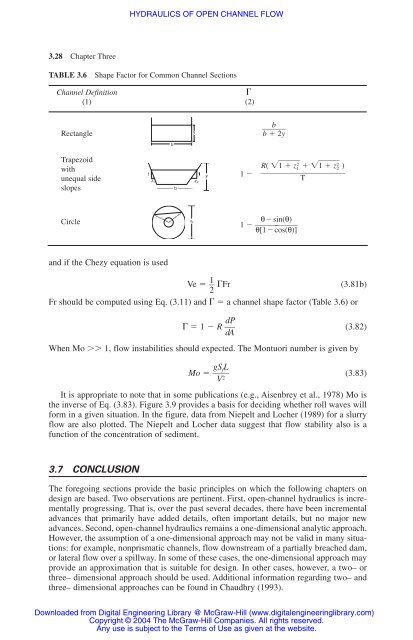chapter 3 hydraulics of open channel flow
chapter 3 hydraulics of open channel flow
chapter 3 hydraulics of open channel flow
Create successful ePaper yourself
Turn your PDF publications into a flip-book with our unique Google optimized e-Paper software.
3.28 Chapter Three<br />
TABLE 3.6 Shape Factor for Common Channel Sections<br />
Channel Definition �<br />
(1) (2)<br />
Rectangle<br />
Trapezoid<br />
Trapezoid<br />
with<br />
unequal side<br />
slopes<br />
Circle<br />
and if the Chezy equation is used<br />
Ve � � 1<br />
� �Fr (3.81b)<br />
2<br />
Fr should be computed using Eq. (3.11) and ��a <strong>channel</strong> shape factor (Table 3.6) or<br />
� � 1 � R � dP<br />
� (3.82)<br />
dA<br />
When Mo �� 1, <strong>flow</strong> instabilities should expected. The Montuori number is given by<br />
Mo � � gSfL<br />
� (3.83)<br />
V2<br />
It is appropriate to note that in some publications (e.g., Aisenbrey et al., 1978) Mo is<br />
the inverse <strong>of</strong> Eq. (3.83). Figure 3.9 provides a basis for deciding whether roll waves will<br />
form in a given situation. In the figure, data from Niepelt and Locher (1989) for a slurry<br />
<strong>flow</strong> are also plotted. The Niepelt and Locher data suggest that <strong>flow</strong> stability also is a<br />
function <strong>of</strong> the concentration <strong>of</strong> sediment.<br />
3.7 CONCLUSION<br />
HYDRAULICS OF OPEN CHANNEL FLOW<br />
b<br />
y<br />
b<br />
�� b � 2y<br />
The foregoing sections provide the basic principles on which the following <strong>chapter</strong>s on<br />
design are based. Two observations are pertinent. First, <strong>open</strong>-<strong>channel</strong> <strong>hydraulics</strong> is incrementally<br />
progressing. That is, over the past several decades, there have been incremental<br />
advances that primarily have added details, <strong>of</strong>ten important details, but no major new<br />
advances. Second, <strong>open</strong>-<strong>channel</strong> <strong>hydraulics</strong> remains a one-dimensional analytic approach.<br />
However, the assumption <strong>of</strong> a one-dimensional approach may not be valid in many situations:<br />
for example, nonprismatic <strong>channel</strong>s, <strong>flow</strong> downstream <strong>of</strong> a partially breached dam,<br />
or lateral <strong>flow</strong> over a spillway. In some <strong>of</strong> these cases, the one-dimensional approach may<br />
provide an approximation that is suitable for design. In other cases, however, a two– or<br />
three– dimensional approach should be used. Additional information regarding two– and<br />
three– dimensional approaches can be found in Chaudhry (1993).<br />
1 �<br />
R( �1� �� z� 1 2� � �1� �� z� 2 2� )<br />
���<br />
T<br />
θ�<br />
sin(θ)<br />
1 ��� θ[ 1�<br />
cos(θ)]<br />
Downloaded from Digital Engineering Library @ McGraw-Hill (www.digitalengineeringlibrary.com)<br />
Copyright © 2004 The McGraw-Hill Companies. All rights reserved.<br />
Any use is subject to the Terms <strong>of</strong> Use as given at the website.

















